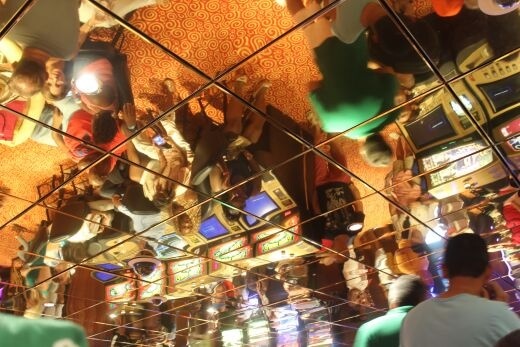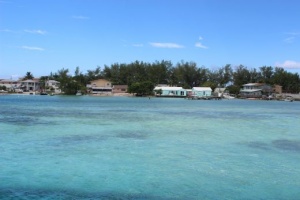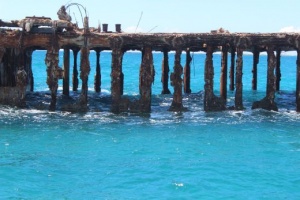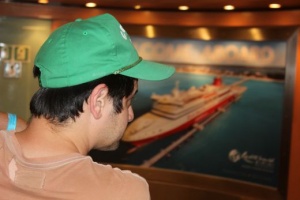- MOVING IMAGE: Screendance in Miami

- A LIST OF TRASH from Legion Picnic Island (and Surrounding) in Biscayne Bay
NO MORE SAND: Thoughts Composed Discursively aboard the SuperFast Gambling Boat Somewhere between Miami and Bimini
Nick County

I boarded on a Friday evening with my friend and editor as well as plenty of cash that I half-expected to never see again. The boat has an impressive exterior, lavish white with red lettering and a sleekness that suggests it will make good on its “SuperFast” promise. On the inside, it is less impressive, predictably cramped and hastily arranged as if, once inside, the jig is up, you have already come too far, and the trap has been sprung (“abandon all hope ye who enter here”). As it turns out, the SuperFast Gambling Boat to Bimini is not as gambling-centric as I imagined. Gambling is merely one way of spending time aboard the ship and certainly not the focal point. People gather at the outdoor bar, where a band of Malaysians crank out mild, mid-tempo, American summer jams of the ’70s and ’80s. On the roof, there are dance competitions and giveaways, with a hype man in a tropical shirt getting everyone into that loose, cruising spirit. There is bingo, which was very well attended and maybe should be counted as gambling, although no one wants to think of his grandparents as degenerates.
The day was inauspiciously overcast, and it was no surprise when the skies opened and began pounding the land and water below with a furious rain. We retreated to the gambling floor, deep in the belly of the ship: a smallish room, as casinos go, with a low ceiling and hardly any space at all for non-gamblers. There were maybe two hundred people inside, but the gaming would have to wait until we hit international waters. We passed the time getting friendly with the blackjack dealer, who was setting up her station. She asked us to guess where she was from, and I lost my first money of the trip when my editor was able to guess the Phillipines before I could. We spent the next few hours drifting between roulette and blackjack, not up or down any noteworthy amount.
Casinos are funny places. They come in many different forms: on boats, in buildings, in houses, on rivers, in oceans, and, if you want to be flexible with definition, in the convenience store, on the Internet, in alleyways, and anywhere money is changing hands through prospecting the unknown outcomes of the future—clandestine, illicit, completely legitimate, or somewhere vaguely in-between. Gamblers bet on games of chance, games of skill, on the stock market, on elections, on whether they can do a backflip, will get breast implants, can run a marathon in the desert heat, or if they can live in an Iowa town for a certain period of time without going completely insane. People are fond of talking about how traditional casinos pump oxygen into their atmosphere, how there are no clocks, how the exits are impossible to find, how the food is always too salty. What is often not talked about is how this constructed environment can nudge you into a different energy dimension, where concepts like time, oxygen, money, and escape cease to have any real meaning. When you arrive, you exchange your cash for chips. This transference is one of many, as you have to forgo all the trappings of logic and reality in the material world. The bouncing balls and the flying dice, the endless drinks and the air of chain-smoke, the hypnotic quality of varying metallic sounds, fired off in regular intervals and mingling with the carnival lights—all these converge to create a quality of suspended belief that is absolutely essential to existence in the casino universe. This frenetic reality is improved when, intermittently, a notion materializes and reminds you that you are actually inside a very large boat that is, at this very moment, slicing through the open waters of the Atlantic Ocean.
People have been gambling on boats for centuries. The nautical gambling vessel conjures images of the mighty Mississippi River, the American South, and of the great Mark Twain. An avid gambler and poker player, Twain was also fond of depicting the hustlers, charlatans, swindlers, and cheaters who are as synonymous with gambling as the whiskey and the women and the dice and the decks. There’s a story that finds Twain and a few miscellaneous businessmen aboard the yacht of Congressman T. B. Reed traveling somewhere in the Caribbean, embroiled in a serious poker game. Twain reports that at one point Reed won twenty-three pots in succession. After that, he says, they made no more stops. When the ship’s captain announced an approaching port, he was told, “Sail on and do not interrupt the game!”

These days, you don’t have to take a boat out to a suspicious shack in the middle of the bay to get a good gamble going. You can round up the kids and the wife and spin it off as a family vacation, complete with activities for everyone. While gambling on the boat, I met a middle-aged pharmacist whose sole aim of the trip, it seemed, was to make new friends. How quaint! Surely an improvement on sitting next to the drunk pirate on a shack in the open water who plans to rob you blind the second you attempt to traffic your winnings back to mainland.
When we finally put our feet down on Bahamian soil, my eight hundred new friends and I were herded into a big white tent with a DJ pumping dancehall calypso on the newly constructed asphalt dock. On the tram to the hotel, we were sandwiched between a blackout drunk FSU frat boy angrily imploring his girlfriend to “go hook up with someone else,” and a forty-something trio of swingers who were hardcore necking like it was four am in a European discotheque. Just across the way, in another tram, about a dozen girls decked out in bachelorette apparel wooed loudly, announcing, in reverse-siren fashion, the arrival of all the dumb Americans who were drunk and ready to spend their money.

The SS Sapona is a concrete-hulled ship that was commissioned by Woodrow Wilson for WWI. When the war was over, it was decommissioned and sold for scrap to the visionary architect of Miami Beach, Carl Fisher. Sometime later, Fisher sold the Sapona to Bruce Bethel, a prohibition-era profiteer who used it to store alcohol off the cost of Bimini, as well as to house a brothel and a casino. During the great 1926 hurricane, it ran aground five miles off the coast of Bimini, and there it has sat for close to a century. By now it looks like a rotting train—rusted over, riddled with large, asymmetrical holes (the navy used it for target practice and training around WWII) and covered in wild graffiti. There is something ominous to this large, graffitied vessel of yesteryear, still standing tall and imposing in the middle of the ocean like some kind of atoll or dead volcano. To swim inside the boat, and imagine it full of people, drinking and drugging, gambling and fucking, as if the world could end tomorrow, made me a little sad at how sterile my experience on a gambling boat thus far had been. I can’t imagine that the SuperFast could ever be this kind of artifact for the hundred-years-from-now version of me, but maybe the global economy will crash and a terrible hurricane will place it at the bottom of the sea, where future gambling historians, very much alive, may dive deep and observe the ways we long-dead gamblers gambled one hundred years ago.
The casino on the island is small and it caters mostly to high-stakes gaming—out of the six blackjack tables they had set up when we arrived at one am, none had a lower stake than a one-hundred-dollar minimum per hand. The dealers on the island were all Bahamian, and were friendly at times, surly at others. Only a couple of the tables had patrons—high-stakes-looking guys smoking cigars and drinking red wine, with blonde women in red lipstick and black cocktail dresses. As it turns out, there was a very famous ex-Miami Dolphin who was living it up all weekend in the high-rollers section. With little choice, we saddled up to the roulette tables, and donated a bit of our coin to the house.

Resorts Bimini World is a partnership between RAV Bahamas, a real estate development company located in Miami Beach, and Genting Group, the Malaysian mega-corporation that bought and controversially seeks to convert the former Miami Herald property into the largest casino in the world. Bimini World Resorts is a
seven-hundred-fity-acre property, which comprises about a third of the North Bimini island. It is the speculation of some that the resort’s intention is to eventually absorb the rest of the island.
Clearly, this is a significant moment in the island’s history, and while colonialism and non-native benefaction is not new there, the severity of the looming future, where the island’s identity will be totalitarian in its pursuit of fun and relaxation, could very well erase much of the natural and cultural properties of the Bimini that existed in the pre-Genting era. With the influx of tourists from the SuperFast Gambling Boat, the island’s population roughly doubles, and it isn’t hard to pick out the ruddy, Midwestern-looking contingent that swarm around the T-shirt shops, conch shacks, and sweet-bread bakeries. If you ask a tourist about the Bimini locals, you are likely to get bubbly, enthusiastic answers about the warm and friendly people they have encountered. Sure enough, when we foolishly got our golf cart stuck in the sand, there were a few kind people who instantly appeared and gave us the much-needed aid to dislodge it. We had a quick laugh at how helpless we were and we were told, “No more sand!”
At night, the island’s peaceful tropical facade is veiled with a ghostly air familiar to Caribbean towns. We drove our golf cart down Kings Highway, the main thoroughfare that runs the length of North Bimini, and takes you to Alice Town, the commercial hub at the end of the island. There is certainly a magic to Bimini, and it isn’t hard to locate that ephemeral human feeling that can lead to thinking you have found the fountain of youth, as Ponce de León once thought while here, or the lost city of Atlantis, as many believed accounted for “Bimini Road,” a submerged formation of rectangular limestone blocks located off the coast. This is also the island where Martin Luther King was rumored to have composed part of his acceptance speech for the Nobel Peace Prize and where Ernest Hemingway wrote much of To Have and Have Not, his book about running rum from Cuba to Key West and his only novel that takes place on American soil. There is a weight to Bimini that demands a consideration of the supernatural and the unknown quantities of the universe and the human imagination.
The first settlers of the Bahamas and Bimini are believed to be the Lucayans, who began exploring the island somewhere between 500 and 800 AD, paddling in dugout canoes from the islands of Cuba and/or Hispaniola. Many accounts of Bimini’s history begin with the families who settled the island in the 1840s, and subsisted on some farming and fishing, but mostly on wrecking, an outdated practice of salvaging cargo from shipwrecked commercial vessels, sometimes involving intentionally luring the ships into doomed channels using false guiding lights. Bimini was a hub for this activity, located on a particularly treacherous stretch of the Florida Straights and the Gulf Stream, making it a popular channel for merchant ships sailing to and from Cuba and the Caribbean. Bimini was also an important location for rum running, and other illicit prohibition-era activities, and later, for the drug trade.
It’s hard to argue with the job stimulation created by the resort, economically or otherwise. One Bahamian I spoke with who is employed through the resort held the opinion that anyone who wants to be employed can be, but many simply refuse to work. The history of economical pursuits on the island is such that he reasoned it has created a culture in which working every day is not the norm. Rather, one could historically work for a few days to make enough money to subsist for the rest of the month. This plays into the island stereotype of easy, languid living, and there is no shortage of Bahamians kicking back under a shady tree, drinking beer, and socializing for the better part of the day. I don’t know if you can un-marry this relaxed facade and the soul of the island, where energy and time exist on their own plane and you can lose yourself behind the cemetery at the island’s end, where, if you walk over the grassy hill, you can see yet another rusted-out ship with the backdrop of electric-blue water that stretches on into the endless tropical horizon. There is a sincere feeling of peace you can find there, if you just stand still and look out into the water.
Bimini is a hell of a place to visit, and I can see why people want to get there, by hook or by crook. To take a gambling boat to a tropical location was a beautiful dream to me, and I’m glad I did it. I hope the island can find a way to be everything to everyone and keep the parts of itself that make it what it is, as well as be a home to the people who live there. Many visions of paradise are manufactured realities. We need look no further than Miami Beach to remember that the sands of much of the island are imported from somewhere else. Carl Fisher was fond of his “tropical illusions” and it would appear that fifty miles away, some people are taking a page out of his book. Sometimes it’s hard to find the weight of the present, when there is so much past and history colliding, and it’s hard to see what is good and what is bad without the perspective of time and the lessons of the past. There is always collateral damage when changes are afoot and a nostalgia for what once was isn’t always fair or true. The future of Bimini is uncertain, and only the passage of time will reveal the winners and the losers of this super fast, high-stakes wager.
Nick County is a writer, gambler, and semi-retired country singer who lives on Normandy Isle with his wife and Chihuahua. You can listen to his latest album, “Nick Count y and the Big Texas Assholes: In the Valley of the Red Sun” at nickcounty.com.









